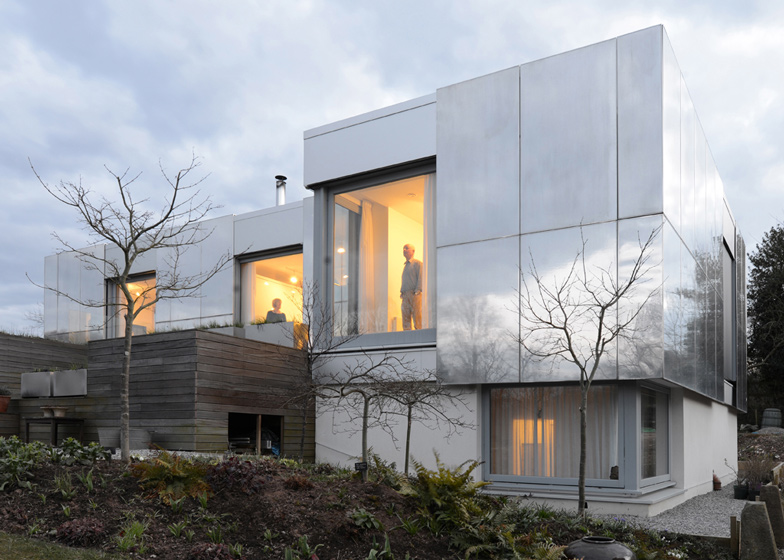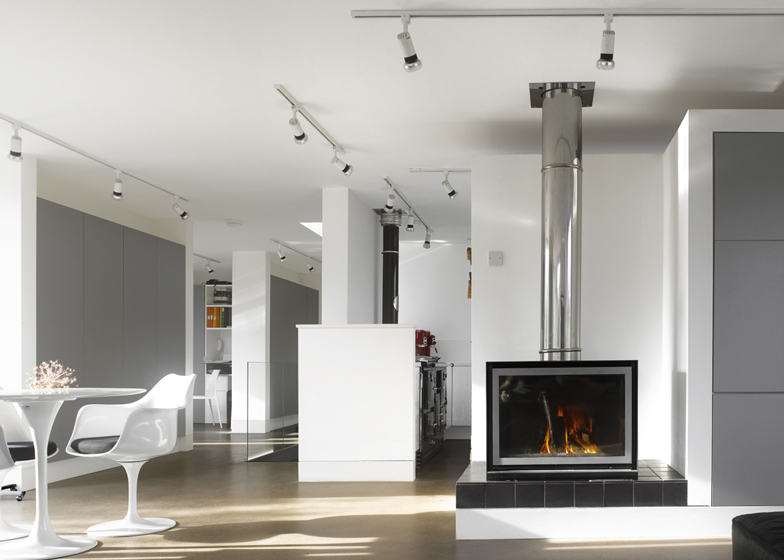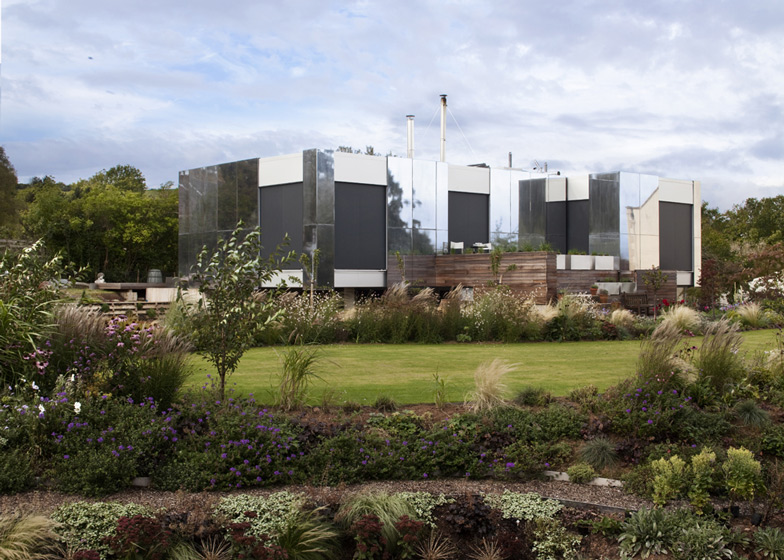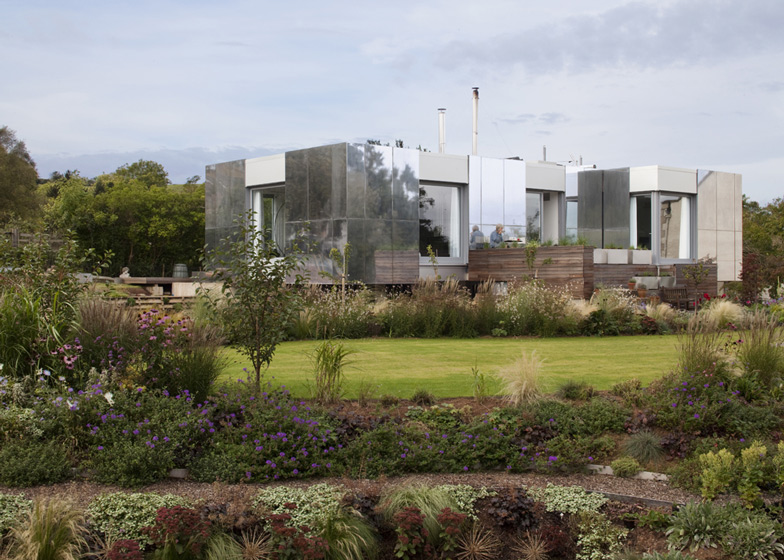This house in western England by London studio Paul Archer Design features a mirrored facade that slides across to cover the windows (+ slideshow).
Surrounded by gardens, Green Orchard house is designed to camouflage with the landscape, so Paul Archer added huge panels of polished aluminium to the walls. "The outer reflective panels will pick up the colours of the landscape, the idea being to make the structure almost invisible," he says.
The panels are well insulated and connected to a motorised system, so that the client - Paul Archer's mother - can transform the building into a thermally sealed box with relative ease.
The house has two storeys, including one that is sunken into the inclining landscape. The living room, dining room and kitchen occupy an L-shaped space on the ground floor and lead out to terraces on both the south-west and north-east elevations, designed to catch the sun at different points of the day.
The master bedroom is also on this floor, while three extra sleeping rooms are located on the sunken lower level. Part of this floor emerges from the ground, allowing enough space for a few high-level windows.
A wood-burning stove is positioned at the centre of the plan and provides all of the house's heating. A 93-metre well supplies fresh water, which can be heated via thermal solar panels on the roof.
"Whilst unashamedly contemporary in its design, Green Orchard is a sensitive response to its location, integrating appropriate materials and functional details to create an innovative and tangible solution to current environmental issues," says Archer.
Several buildings with mirrored walls have cropped on Dezeen recently. Others include an Australian visitor centre for botanic gardens and a six-sided art museum in Ohio.
See more mirrored buildings »
See more houses in the UK »
Photograph is by Will Pryce, apart from where otherwise stated.
Here's the full project statement from Paul Archer:
Green Orchard: A Zero Carbon House
Compton Greenfield, South Gloucestershire, UK
Green Orchard is a new 200 sq m carbon-neutral house designed by Paul Archer Design. Set within 2,675 sq m of landscaped gardens in the green belt of South Gloucestershire, the house benefits from spectacular views over the Severn Estuary.
Having earned a reputation for highly contemporary residential extensions and renovations predominantly in an urban setting, Green Orchard is the practice's first new-build detached single-family dwelling commission. The project brief called for a Californian case study house with green credentials, which would permit seamless outdoor/indoor living whilst delivering a zero carbon agenda.
The house replaces a dilapidated single-storey dwelling with a contemporary low-rise four-bedroom home. Set within landscaped gardens without the constraints imposed upon typical urban projects, Green Orchard is designed in the round, with all four elevations taking advantage of views out and access to the garden. Maximising its rural setting, the house adopts the methodology of a passivhaus typology without the single orientation.
The main living spaces and master bedroom are located on the ground floor with direct access to the garden. An excavated sunken level creates a second floor for additional sleeping accommodation, ensuring a low-rise profile that embraces the natural topography of the site.
The house incorporates four bedrooms (two of which have en-suite facilities), a main bathroom, a workshop space, kitchen, dining and living area. All living spaces are open-plan with a wood burning stove at the heart of the plan and plant room located on the floor below, to give a greater sense of openness and maximise views and sunlight. Two external terraces connect to the garden and are orientated to catch the sun at different times of the day.
The outer skin of the building is made of bespoke hand-crafted full-height panels, which are electronically motorised to slide open fully. The panels are highly insulated and allow the occupants to control and vary the thermal performance of the house depending on the time of the day and year. The panels are constructed of locally sourced timber and clad with mirrored aluminium to reflect the landscape and camouflage the structure in its surroundings.
The house and landscape have been designed with specific intention to reduce the consumption and requirement for energy: a wood-burning Stuv stove is the only heat source; water is supplied by a 93 metre bore hole; thermal solar panels on the roof yield heating for 80% of the house's water; and photovoltaics provide all electric use when taken over the yearly cycle. A green roof embeds the property into the landscape, filtering out pollutants from the surrounding air and acts as an effective active insulation. It keeps the building cool in summer and warm in winter, reducing the requirement for excessive energy production.
Set in gardens cultivated by the client, Green Orchard is screened from its neighbouring properties and road frontage. A sunken driveway and raised garden reduces the visual impact of the house and planting provides a tranquil setting from which to enjoy the countryside views.
Green Orchard is the second house the practice has designed for the same client, practice director Paul Archer's mother and her husband. The plan allows for easy navigation and access to all areas whilst generous room sizes and a flowing internal layout ensures that manoeuvrability is unhindered, an essential consideration when designing for a client in their later years.
An innovative house has been achieved on a modest budget by designing the entire house to accommodate modular off-the-shelf interior units. The client has taken a hands-on approach to deliver high quality finishes by contributing their own expertise, from the design and planting of the garden to the carpentry of the exterior sliding panels and manufacture of the interior glass balustrades.
Whilst unashamedly contemporary in its design, harnessing the latest in green technology, Green Orchard is a sensitive response to its location, integrating appropriate materials and functional details to create an innovative and tangible solution to current environmental issues, presenting a way forward in designing for a sustainable future.





